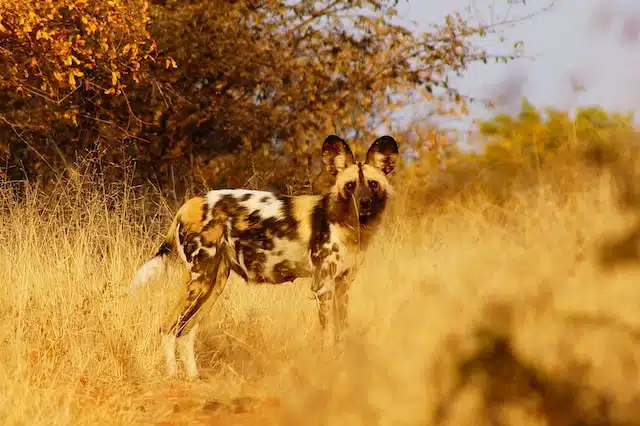Welcome to the African Wild Dog!
The African Wild Dog, also called the “colorful wolf,” looks like a colorful dog. Its black fur is patterned all over with large spots. Despite its name, the African wild dog is very different from domesticated dogs, which have a very different origin from these fantastic creatures.
It is a beautiful but also very dangerous hunter in the African Savanna and one of the world’s most endangered animals. If you want to see these rare creatures in person, check out our Article on the best places to find them.
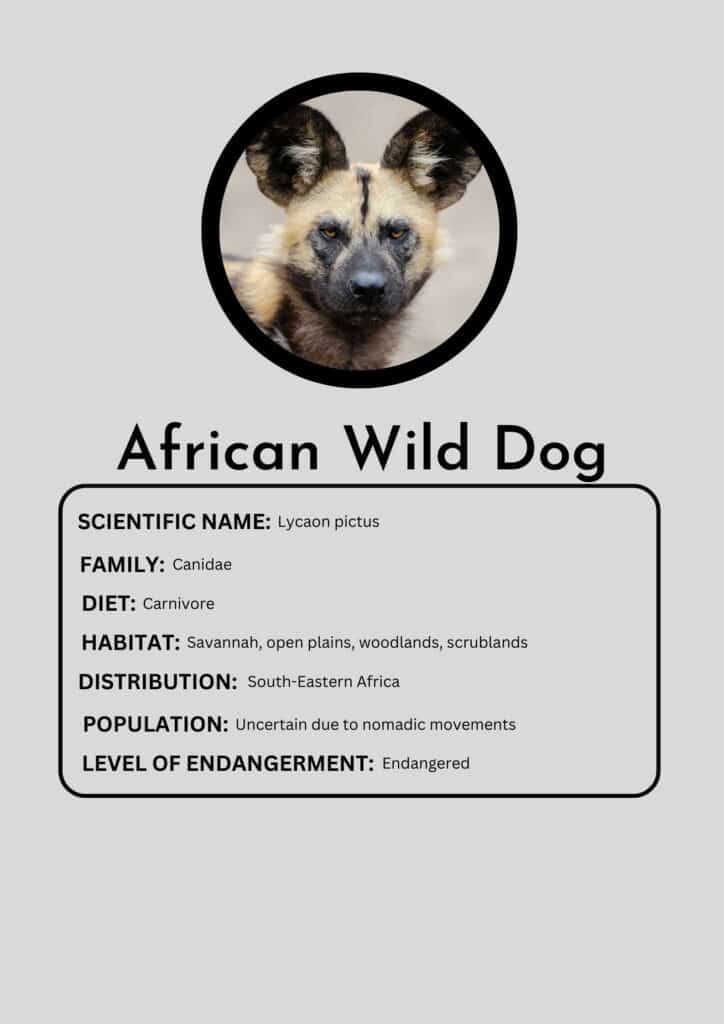
Key points
| Appearance | Distribution | Diet | Mating and Life Cycle | Cause of Endangerment | Fun Fact |
|---|---|---|---|---|---|
| – African Wild Dogs have a speckled coat with black, yellow, white, and yellow markings | – Native to Africa | -Hypercarnivorous diet primarily consisting of meat | – Packs are highly social with strong family bonds | – Threatened by human attacks, habitat fragmentation, diseases, and predation by lions | – African Wild Dogs communicate through various vocalizations and have a complex greeting ritual |
| – Rough bristle-like hairs | – Range limited to southern and southeastern parts of Africa | – Target medium-sized animals such as Impalas, antelopes, warthogs, and rats | – Dominant monogamous pair leads the pack | – Conservation measures include wildlife corridors and building closures for cattle | – They “vote” through sneezing sounds to decide when to initiate a hunt |
| – Personalized coat with spots that distinguish individuals | – Prefer savannah and open plains; can reside in woodlands, scrublands, and mountainous areas | – Hunt in packs of 6-20 individuals, using teamwork to drive prey to exhaustion | – Gestation period is approximately two months, with up to 20 pups in a litter | – Population decline due to habitat fragmentation, human activity, and predation by lions | – A loud greeting call (“hoo”) can reach across a distance of 4 km |
| – Males and females measure around 24 inches in height and weigh 35-50 pounds | – Found in Zimbabwe, Namibia, Mozambique, Zambia, and Tanzania | – Prey includes medium-sized animals; can hunt larger prey like Wildebeests and Zebras | – Pups remain in the den for three weeks and join the pack on hunts at ten weeks old | – Threats include human attacks, habitat fragmentation, and diseases such as rabies | – Sneezing sounds are used to communicate and “vote” on initiating hunts |
| – Endangered species with an estimated population of approximately 1,400 individuals | – Previously occurred throughout the African continent | – Require more food than lions relative to their size | – Mortality rate of pups is relatively high due to various factors; adult lifespan is about 11 years | – Expansion of human development contributes to habitat fragmentation and conflicts with livestock and agriculture |
Appearance
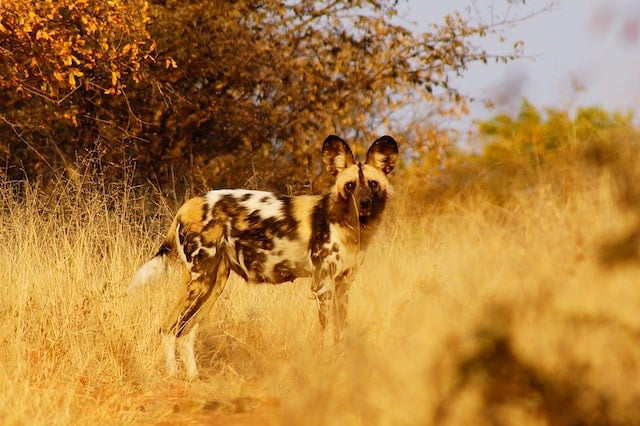
The African Wild Dog belongs to the family of Lycaon pictus, the most significant wild canine to roam the African continent. Due to their speckled coat, they also go by the names of the “painted dog” or the “cape hunting dog.” It is easy to forget that they are, in fact, vicious predators when they look so much like any other cute dog we’d take to the park.
Their coat consists of rough bristle-like hairs, which combine black, yellow, white, and yellow markings. Each dog has a personalized jacket. They can distinguish each other utilizing their spots from a distance as long as 300 ft.
As they age, their coat recedes, leaving senior African Wild Dogs almost naked. Moreover, they have a white-tipped tail, which allows them to keep track of each other during a hunt, and large rounded ears. Another distinctive feature of the African Wild Dog is the absence of dewclaws, the fifth claw that does not touch the ground, typically seen in other dogs.
Males and females do not differ substantially in size. Both roughly measure 24 inches in height at the withers and weigh around 35-50 pounds.
Distribution and Habitat
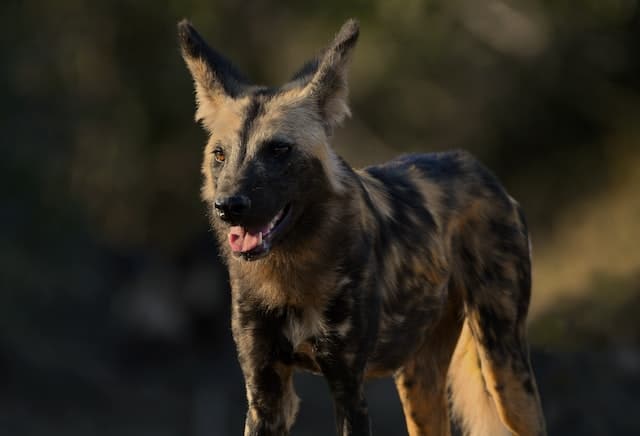
As the name suggests, the African Wild Dog is native to Africa. Previously it occurred throughout the continent, but now their range is limited to the southern and south-eastern parts, most frequently in Zimbabwe, Namibia, Mozambique, Zambia, and Tanzania. If you are interested in a real-life encounter, check out our article on the best places to tour and see them.
They don’t mind residing in woodlands, scrublands, and mountainous areas, but their preferred landscapes include the savannah and open plains, as this grants them unobstructed views when hunting their prey. A thriving pack can obtain a home range of 580 – 900 square miles.
Resulting of habitat fragmentation and human activity, their population has significantly decreased as of late. Although gauging the exact size of their population is complicated by their migratory movements, it is nonetheless classified as endangered.
Diet
An African Wild Dog’s diet is hypercarnivorous, meaning it first and foremost consists of meat. They target medium-sized animals, and their favorite snack is the Impala because of its prevalence, but they enjoy antelopes, warthogs, and rats equally. Giant packs of African Wild Dogs even topple animals as big as Wildebeests and Zebras.
Sorting out dinner is a group project; they hunt in packs of 6-20 individuals. Through teamwork, they drive their target to exhaustion (sometimes reaching speeds of 44 miles per hour) and are very rarely unsuccessful. They are hungry creatures and require more food than lions concerning their size, and prey can be depleted within minutes of catching it. However, if there are pups present, they are allowed to dine first. Unlike most social predators, they will regurgitate food for other pack members, including adults.
Mating and life cycle
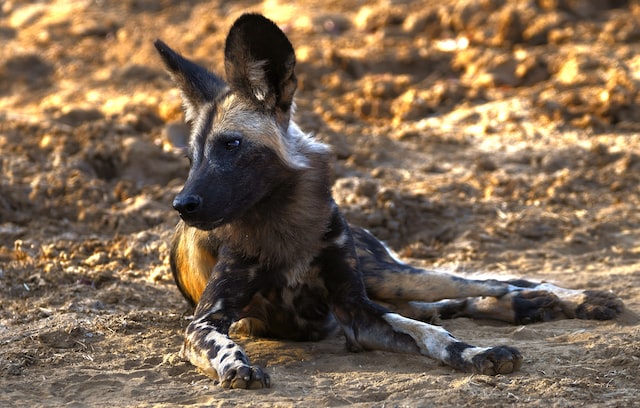
Packs of African Wild Dogs are highly social and have strong family bonds. Both female and male dogs care for pups, and ill or injured members are never left behind. Typically a dominant monogamous pair leads the pack. Packs usually consist of 10-20 individuals, although this number sometimes stretches to 40.
The gestation period is roughly two months, after which females give birth to a litter of up to 20 pups – more significant than any other canid’s litter. Due to their large waste size, it is generally only the dominant female that reproduces. The dominant female may even kill subordinate pups to control the pack’s size.
Pups remain in the den for three weeks and wean off their mother until they reach five weeks. By ten weeks old, they join the pack on hunts. Unusually, female dogs disperse to other groups when having reached sexual maturity.
Sadly, the mortality rate of pups is relatively high. Flooding of their dens, food shortage, and disease are the most common causes of death. Those who do make it to adulthood live to be about 11 years.
Cause of Endangerment
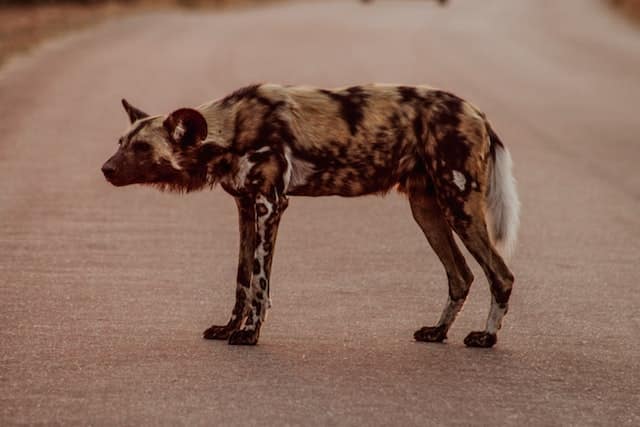
As previously stated, their prevalence on the African continent has diminished significantly. Currently, the total population of African Wild Dogs is approximately 1,400 individuals. Consequently, they are classified as endangered, as per the IUCN.
Due to the threat, they pose to livestock and agriculture; farmers frequently attack them. Expansion of human development similarly causes fragmentation of their habitat. Likewise, they often fall victim to diseases such as rabies or others.

Moreover, lions are prominent enemies of the African Wild Dog. Firstly, they compete for the same food sources – a competition that grows more intense due to habitat fragmentation and because lions hunt and kill them. However, these killings aim to assert dominance as they will leave the dogs’ bodies for vultures to feast on.
Successful conservation measures include the provision of “wildlife corridors,” which attempt to lessen the effects of their habitat fragmentation. Additionally, assisting farmers with building efficient closures for their cattle helps reduce human attacks on African Wild Dogs.
Fun Fact- That We Bet You Didn’t Know
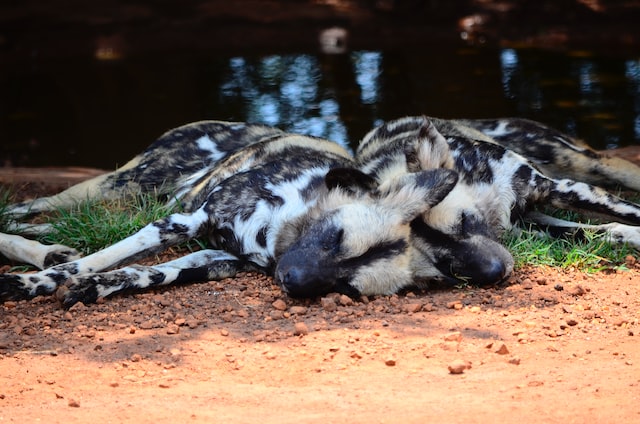
Being highly social animals, they naturally have many different means of communicating with each other. Most frequent is their greeting call, a “hoo,” which is loud enough to reach across a distance of 4 km. Furthermore, they have an intricate greeting ritual they perform before the start of a hunt – this includes sniffing, licking, and wagging their tails.
Attesting to their complex social structures, they “vote” through a sneezing sound about whether they should hunt at a given time. If a subordinate dog initiates a hunt, several ten sneezes will tip the scale in favor of the search. On the other hand, if a dominant member of the pack creates a hunt, three sneezes will suffice.
Summary
The African Wild Dog, an endangered species in Africa, is known for its distinct coat and cooperative hunting. They hunt in packs, targeting medium-sized prey through teamwork and impressive speeds. Habitat fragmentation and human activities have led to a decline in their population. Conservation efforts focus on creating wildlife corridors and mitigating conflicts with farmers. African Wild Dogs exhibit strong family bonds and care for their pups. Preserving their unique behaviors and habitats is crucial for the survival of this remarkable species.
Thank you for reading about the African Wild Dog. Also, look at our other Mammal articles or about the Most Endangered Animals.
Frequently Asked Questions (FAQ)
Q: What are wild dogs?
A: Wild dogs, also known as African wild dogs or painted dogs, are a species of canines native to Africa. They are highly social and have unique coat patterns.
Q: How are wild dogs different from domestic dogs?
A: Wild dogs differ from domestic dogs in terms of their habitat, behavior, and hunting patterns. They are larger than most domestic dogs and have distinct coat markings. Unlike domestic dogs, they primarily live in the wild and hunt in packs.
Q: Where do wild dogs live?
A: Wild dogs are found in various countries across sub-Saharan Africa, including Zimbabwe, Namibia, Mozambique, Zambia, and Tanzania. They inhabit a range of ecosystems, including woodlands, savannahs, and open plains.
Q: What do wild dogs eat?
A: Wild dogs are carnivorous predators with a diet primarily consisting of meat. They target medium-sized prey such as impalas, antelopes, and warthogs. They are also known to hunt larger animals like wildebeests and zebras in coordinated packs.
Q: How do wild dogs hunt?
A: Wild dogs are highly efficient hunters. They use their excellent teamwork and endurance to chase down prey, often engaging in long-distance pursuits. They employ strategic tactics to tire out their target before making a successful kill.
Q: Are wild dogs endangered?
A: Yes, African wild dogs are classified as endangered. Their population has drastically declined due to habitat loss, human encroachment, and diseases. Conservation efforts are crucial to protect and preserve this species alongside other endangered animals in Africa.
Q: How many wild dogs are left in the wild?
A: The population of wild dogs is estimated to be around 1,400 individuals. However, the exact number is challenging to determine due to their wide-ranging and nomadic behavior.
Q: Do wild dogs have natural predators?
A: While wild dogs are apex predators, they do face threats from other predators. Lions, hyenas, and crocodiles are known to prey on wild dogs, especially when competition for food arises. Hyenas are especially known for stealing meals.
Q: Can wild dogs be domesticated?
A: Domestication of wild dogs is extremely rare and not recommended. Wild dogs have specific behavioral and social needs that are difficult to meet in a domestic setting. They are best left to thrive in their natural habitats, unlike domesticated dogs who thrive alongside humans.
Q: How can I help conserve wild dogs?
A: You can support wild dog conservation by donating to reputable wildlife organizations, participating in eco-tourism activities that promote responsible practices, spreading awareness about the species, and advocating for habitat preservation and protection.
Join our Forum for free today!


